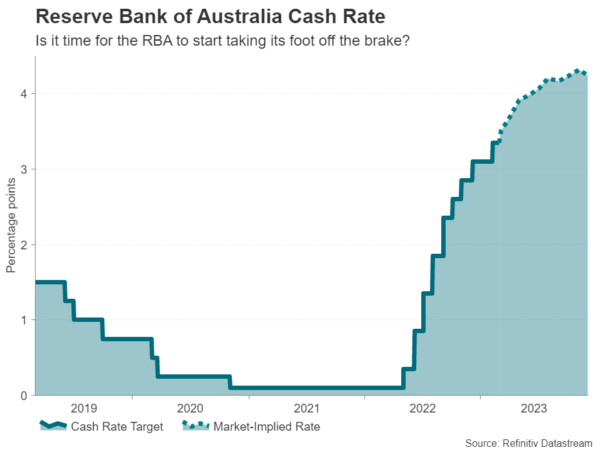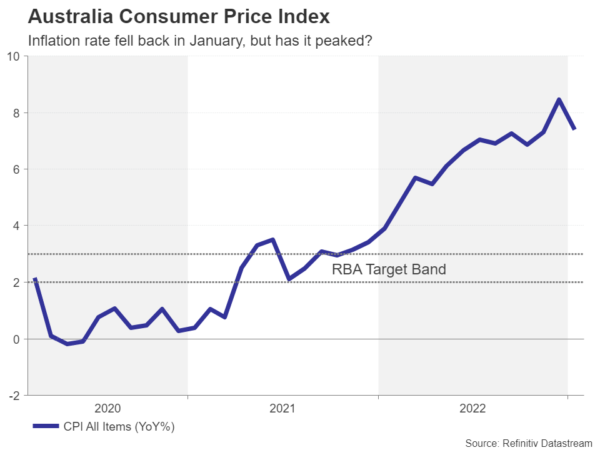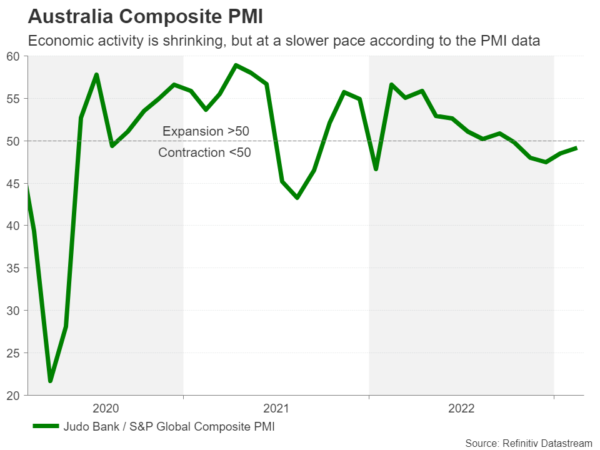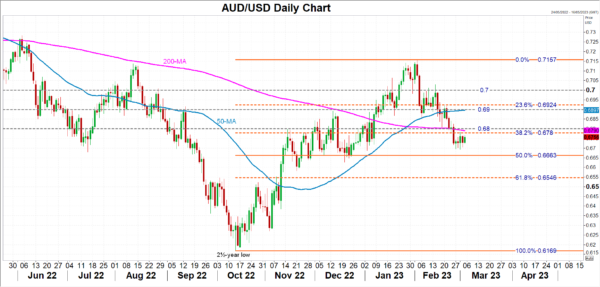The Reserve Bank of Australia is widely anticipated to raise the cash rate for the 10th consecutive meeting on Tuesday as it battles to get inflation down. Having flip-flopped between hawkish and dovish inclinations lately, the RBA may struggle again to get its communication right amid some confusing signals on inflation and the economy. This could make it difficult for the Australian dollar to find a floor under its recent slide.
Danger of stagnation
The Australian economy slowed towards the end of 2022 and the slump in the property market deepened further, with even the hot labour market coming under some strain from the series of hikes in the borrowing cost. However, inflation hit a new three-decade peak in the final quarter of 2022, prompting the RBA to row back on language that was bordering on a neutral stance.
The hawkish tilt from the December meeting to the next one in February was notable and policymakers now expect to raise the cash rate several more times over the coming months. Investors have subsequently fully priced in three 25-basis-point rate increases and another one with equal probability for 2023.
Making sense of the fast-shifting data
Nevertheless, there was some paring back of the rate hike odds following the release of the fourth quarter GDP data earlier this week, which came in below expectations. Other incoming data in the past couple of weeks have also been pointing down. Employment fell for the second straight month in January, wages rose by less than expected in Q4, and the consumer price index moderated significantly in January, easing from 8.1% to 7.2%, Meanwhile, it seems that the housing downturn isn’t quite over despite some signs of the price declines slowing, as building approvals plunged 13.8% y/y in January.
However, more forward-looking indicators such as the Judo Bank/S&P Global PMIs suggest that economic activity may be picking up. In addition, when put into perspective of the bigger economic picture, the slowdown in the jobs market or in broader growth is not that severe.
Inflation not growth likely to be RBA’s main priority
Hence, the RBA will probably not be too worried about recession risks just yet and focus more on the CPI data, and on that, it is too soon to assume that the country is past peak inflation. Moreover, growth in Australia’s biggest export market – China – is bouncing back fast and so the outlook on that front is improving.
With all that in mind, investors may be putting too much weight on the downside risks to the economy and it’s probably premature to be talking about a pause when both headline and underlying measures of inflation remain so elevated. For now, a 25-bps rate hike is almost certain at the March decision, which means the focal point of the meeting will be any changes to the wording of the statement.
There could be some upside for the aussie
If Governor Philip Lowe reinforces his message that there is further tightening to come, this could provide some boost to the aussie as traders reverse their recent unwinding of rate hike bets. A climb back towards the $0.70 level could be possible, although that would require overcoming several major hurdles such as the 200- and 50-day moving averages in the $0.68 and $0.69 regions, respectively.
However, should Lowe fail to portray a convincingly hawkish tone by emphasising the risks to growth, the aussie could slide towards the 50% Fibonacci retracement of the October 2022-February 2023 uptrend at $0.6663. Breaching this would open the door to the 61.8% Fibonacci of $0.6546.
Either way, there’s unlikely to be a marked shift in the RBA’s policy stance until policymakers have a clearer view of what’s happening to inflation and in the meantime, the aussie will be driven mainly by general market sentiment as well as of course by speculation about Fed policy.

















